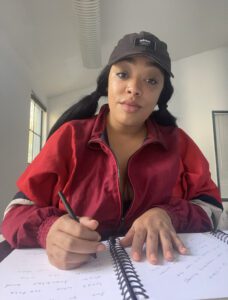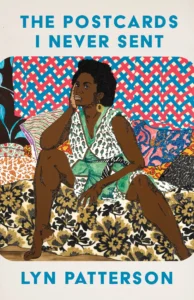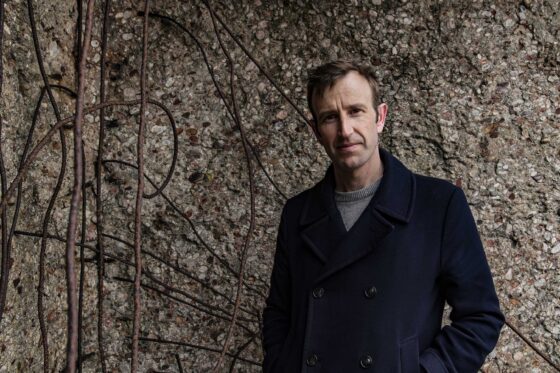
In The Postcards I Never Sent (Black Lawrence Press, 2023), we watch as author Lyn Patterson travels far and wide as a mythical creature on a fantastical voyage. Not a siren or phoenix (though these do appear as metaphors in her work), Patterson is a poet on a mission to become more than just the sum of her ancestry and prior circumstances. She pens letters to her loved ones as she hops from city to city, country to country, in search of herself. Fraught and tenuous are her relationships with her parents, her husband, and herself; the letters serve as bridges via which Patterson strives to maintain a potential path for understanding and healing between herself and those to whom life has tethered her. Through these intimate pages, we witness a different type of hero’s journey—one in which Patterson achieves glory by overcoming the beasts of addiction, generational trauma, racial stereotypes, and other behemoths that often prevent Black Americans, especially women, from becoming self-actualized beings in charge of their own destiny.
Originally from Seattle, Patterson currently resides in Oakland, California, where she is pursuing an MFA and growing her skills as a multimodal artist. In her emailed responses, Patterson adeptly volleys musings about the complexities of Black poetics and dares readers to lay aside their presumptions as they follow her across the worlds of her second collection.
***
The Rumpus: The Postcards I Never Sent greets us four years after your debut collection, Whisperings of the Wild and Wilting. Should readers understand the speaker in The Postcards I Never Sent as a mature continuation of the speaker we encounter inthe first collection, or are they distinct?
Lyn Patterson: What an amazing place to start! I hadn’t considered this question, but upon reflection, I think it’s a balance of both. Both works are profoundly personal, drawn directly from my diaries and personal letters. The first book was about realizing that you are always on a journey toward becoming and evolving. Those poems were written from the ages of nineteen to twenty-nine, and I think you can see the maturation of the speaker as the book progresses.

I wrote the poems for this new collection over eleven months, after I sold all my belongings and hit the road. I went to eleven different countries and too many cities to count. As I traveled, I was grappling with a separation, family dynamics, and a world that felt disillusioning. After reflecting, I also realize that I feel very far away from the version of myself that wrote Whisperings of the Wild and Wilting, though I do think that readers who are familiar with that work will see an evolution in my voice and the themes I explore. So, these works are both distinct and interconnected—a continuation of my journey. I’m excited to continue unpacking this idea as other people read it and even see connections and divergences from my first collection.
Rumpus: In the preface of this collection, you state that your “goal as an author is to tell necessary stories of Black existence, unapologetically, with both nuance and simplicity” and that “mainstream Black storytelling has centered around the narrative of struggle and resistance.” Can you share some aspects of this collection’s speaker and her journey that embody overlooked or underappreciated facets of Blackness and what we might learn from them?
Patterson: In my collection, I delve into the theme of intergenerational healing within Black families. Through poetry, I explore the intricate journey of understanding and addressing inherited trauma and breaking cycles of pain as it relates to things like addiction, self-sacrifice, and chasing our version of the American dream.
A core thread in my work is the exploration of family power dynamics, particularly gender roles concerning love and marriage. I dig into these complex dynamics, unpacking the layers of expectations, struggles, and negotiations that shape familial relationships. While writing this collection, I was recently married and going through a separation, so I was hyper-aware of societal expectations regarding wifehood. I took the train to Montreal when I bought the book Difficult Women by Roxane Gay. I loved how flawed those Black women were. Gay’s perspective diverged from mainstream storytelling about Black women being martyrs, a role the women in my family took on as wives and mothers.
Another aspect that embodies overlooked facets of Blackness is family ancestry tracing. While writing this collection and traveling, I was doing family research and trying to reconnect with long-lost ancestors. Here, I encountered stark challenges faced by many Black people in America who are hoping to uncover their roots due to the legacy of slavery. My inability to trace census records before 1851 highlights a historical barrier that often goes unnoticed in discussions of Black identity, [and] the struggle to name my ancestors reflects a broader theme of reclaiming lost histories. Additionally, the exploration of physical spaces tied to my ancestors underscores the impact of displacement on Black communities, offering insights on the power of being able to place yourself in space and time, which are often overlooked.
Regarding learning and takeaways, I’m not sure that’s always my role as a poet or a teacher. I think it can be powerful to share your truth in its rawness and for people to find connections and make their own meaning. Blackness is not a monolith. My story is just one, but our unique perspectives contribute to creating a richer and more complex picture of our collective humanity.
Rumpus: Sometimes authors avoid taking certain risks in their work because they fear being misunderstood or mischaracterized. For example, some Black artists avoid anything that compares Black people to animals for fear that this may reinforce dehumanizing racial tropes. As a poet who comes out the gates of this collection swinging with lines like, “She is a howling creature on a mission, crawling to collect her dreams,” what is your reaction to this, and how does it tie into your understanding of a complex and multifaceted Black life in a heavily racialized society?
Patterson: This is an interesting question and interpretation of that line. I am definitely a Black artist who also avoids this comparison. My book is full of references to Black women being goddesses, universe, earth, revered matriarchs, and martyrs. When I wrote this line, I was thinking about the word “creature” very differently. A creature is any living being, and the word often has a sense of awe and wonder attached to it. At the time, I was learning my family folklore and thinking about mythical and fantastical beings like the goddess Oshun, who often presented herself as a mermaid or siren. In literature and folklore, creatures often symbolize deeper meanings and embody various characteristics beyond their physical form, and I think Black women are often asked to stretch and pull themselves in ways that extend our physical form to be comfortable and seen in a heavily racialized society. Words like “howling,” for example, are not necessarily animalistic either. It was about becoming the wind and acknowledging the wind’s primal force of nature.
Still, I do want the reader to feel a bit disoriented because the poem is about shedding societal expectations of Black women being likable, perfect, or “Black girl magic.” I think a creature can symbolize our most primal instincts, and it can certainly lack beauty. Ultimately, this poem asks the question: Are Black women allowed to be flawed and still lovable? Are we allowed to have a flawed perspective and still have a story worth telling? It is meant to make the reader question their own assumptions and positioning going into the collection.
Rumpus: What place has been the most crucial to your artistic and personal growth, and why?
Patterson: I don’t think there is one physical space that was the most crucial, it’s more about the experiences on the journey of coming home to oneself. Each destination contributed to my understanding of self, creativity, and the world around me. The journey was filled with challenges, revelations, and self-discovery, and the journey of self-discovery has been an ongoing process for me. It’s also taught me that I carry home within me, regardless of where I’m physically located.
Simultaneously, I’ll say, returning home physically stands out the most as I reflect. Particularly, the two to three months off and on I spent with my parents. We reexamined our family dynamics without the overshadowing weight of addiction. My parent was sober by then, which further facilitated our healing journey and provided space for forgiveness and fresh perspectives. It fostered a deeper understanding of myself and my familial relationships, which significantly influenced my journey of self-discovery and contributed immensely to my personal growth.
Rumpus: I’m so intrigued by the intensely tactile aspect of your work. The collection is covered in handprints, various red fluids, assorted wet matter, and prickles from sharp little objects. Why is it important for the reader to feel these sensory intensities alongside the speaker?
Patterson: A huge part of my personal journey while writing this collection was about becoming grounded and rooted in the here and now. I was looking at poems like archives of memories and even allowing old memories (some of which were painful) to come back in full intensity. For me, some of the best poems allow people to make connections to their own lived experiences through feeling their way through it versus intellectualizing or overanalyzing every word for meaning. I think poems are so powerful when they reveal collective shared experiences, and I love using tactile imagery so readers can stand in the shoes of the speaker.
Rumpus: I’m also impressed by how you pack profound musings into compact parcels. In the brief poem “Rum and Stardust,” you address your family’s history of addiction, positing that perhaps your lineage is not cursed, just “uninspired by the earth.” How did you reach this conclusion? Has anything managed to reignite earthly delight within you?
Patterson: Thanks! I love playing with brevity, precision, and simplicity. This collection is deeply personal, and the short answer is that therapy led me to this conclusion. The long answer is that addiction has been cyclical in my family—my great-grandparents, grandparents, and my parents. Being a child of an alcoholic has had a huge impact on how I understand family and belonging. While I was writing this book, I was analyzing all of these connections, and that particular poem is more about the act of reframing experiences.
As I was traveling, collecting family stories, and returning to ancestral lands, I realized that my own search for fulfillment held similarities to my father’s search for fulfillment, and even my grandmother’s. My escape was to leave, but other people escape the uncertainty of their reality through vices. I learned about reframing in therapy, and it can be so powerful because, in this instance, it helped me see these struggles in the context of my own life and give grace to those who raised me. It’s not necessarily a conclusion, I guess, but an inquiry.
I also think there’s a lot of earthly delight in the book! From poems like“Caribbean Symphony” to “Auntie Gina’s House.” My family gives me a lot of earthly delight as well, in belonging and being rooted. Currently, I’m leaning into small joys. Savoring a delicious meal, listening to my dad’s old records, getting into shenanigans with friends, experiencing a new love’s kiss for the first time, and being a new mom. Actually, since writing this collection, I’ve been trying to manifest more of these delights by writing about them. As I was writing this collection, I realized that sometimes I am able to write poetry that is so profound regarding pain. I want to write about joy and healing with the same reverence.
Rumpus: Now, I typically balk at the idea of asking an artist about their love life, but I couldn’t help but notice how your husband, Jeremy, shows up with such intimate complexity throughout the book—he even wrote the collection’s introduction! How has your relationship with your husband ignited the poetess within you and affected the context in which you view yourself?
Patterson: The day we got married, my husband gifted me a travel journal. It was his way of affirming that he’d always support my need to wander and experience the world. When we separated, I brought it along while I traveled for those eleven months. All the poems in this collection started out as letters and reflections from that journal my husband gave me. When I wrote them, I was grappling with saving the relationship and imagining my life without him, which was really disillusioning. That notebook became my space to write to him figuratively when we were not communicating. When I look back at those “Dear Jeremy” letters, I see so much of my internal struggle and evolution. I was writing to him even as I was self-actualizing. In that way, he was a catalyst for this collection. I’ve realized that examining love and belonging is a huge source of inspiration for me.
Still, I never imagined that so much of that journal would make its way into the collection. When I was designing the manuscript and seeing the collection’s potential as a memoir, it felt important to help orient the reader to the journey, and my letters to him felt like the most authentic way to do that. Each “Dear Jeremy” letter is taken directly from that travel journal verbatim.
It’s funny, my editor and I were thinking of people who could write the introduction. We went through a long list of people, but no one truly felt right. My husband is a wonderful writer. He edits all my manuscripts before they see other editors. As I was explaining this to my editor, the idea arose for him to write the introduction, so we gave it a shot. His written introduction felt like a missing puzzle piece.
Rumpus: Speaking of Jeremy, you both use the collection to insist that “even when it burns, it’s still poetry.” Can you elaborate more on the “it” here and tell us why it has made your marriage and life so poetic despite the flame?
Patterson: A poem excerpt reads: “You broke my heart and it’s heavy. Because I still love you enough to make beautiful things, even out of your flaws. Even when they hurt me. For you, I will always find the words. Even when it burns, it’s still poetry.”
In this context, “it” symbolizes the raw emotions and complexities of love and heartbreak. Despite the pain and turmoil caused by someone’s actions, the experience can remain beautiful because we can transform experiences into art. That’s powerful. Through art, we find solace and catharsis in creating something profound from even the most painful experiences. This entire collection was written during one of the most challenging journeys of my life, but there is beauty in all the lessons learned. Now that time has passed, I can see how these painful experiences have contributed to my overall growth and development. Writing through them gave me a sense of groundedness and confidence, allowing me to keep inspiring and healing even when it “burned.”
Rumpus: In the collection’s closing poem, “Fruit,” we see a reconsideration of the late bloomer concept in the insistence that “you were never meant to be a flower, you have always been fruit.” How did you come to this conclusion, and what else should readers understand about this distinction between flower and fruit?
Patterson: This feels really full circle because it beckons back to the maturation of the speaker. In my first collection, I end with “if I can be anything, I want to be wild. Not wild like the wind. But wild like the flowers. Innately in-tune with the earth, ever evolving. Through dirt and decay always finding a way to blossom, to bloom.”
The poem “Fruit” in this new collection delves into the distinction between flower and fruit as a metaphor for purpose and maturation. In my first collection, the desire to be wild like the flowers, symbolized a journey of beauty and evolution despite challenges. At the end of this collection, the distinction between flower and fruit lies in their purpose. If a flower’s purpose is to be beautiful, the fruit serves a different role—it exists to be harvested and to nourish other living things. In the poem, this distinction is highlighted as a deeper reflection on the essence of purpose and growth and honors both flower and fruit as an observation of the natural world’s life cycles. I hope readers will draw parallels between the natural world’s life cycles and human existence, understanding the essence of purpose and how we evolve and contribute to everything around us.
***
Author photograph courtesy of Lyn Patterson




